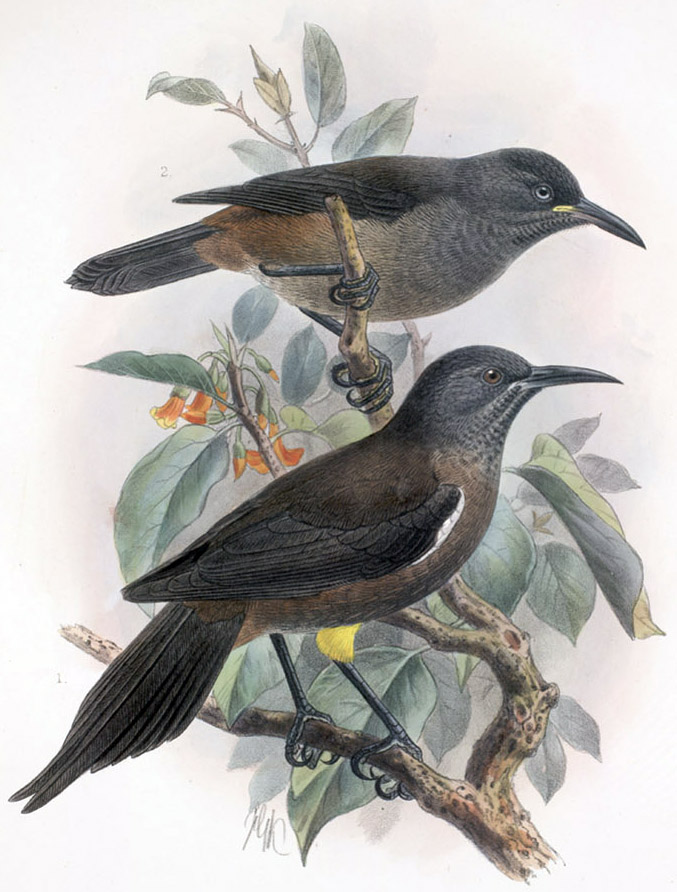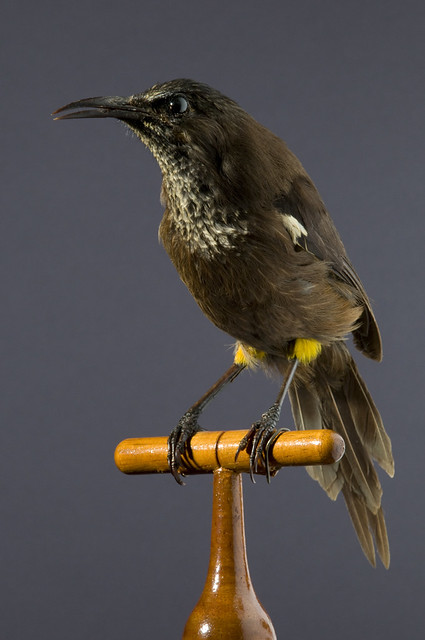Post by Infinity Blade on Jun 17, 2020 2:37:47 GMT 5
Kaua’i ʻōʻō - Moho braccatus

Illustration of an adult and juvenile Kaua’i ʻōʻō. Created in 1883 by Walter Rothschild. Image source->
Temporal range: Holocene (last heard in 1987 CE)
Scientific classification:
Life
Domain: Eukaryota
(unranked): Unikonta
(unranked): Opisthokonta
(unranked): Holozoa
(unranked): Filozoa
Kingdom: Animalia
Subkingdom: Eumetazoa
(unranked): Bilateria
Clade: Nephrozoa
Superphylum: Deuterostomia
Phylum: Chordata
Clade: Olfactores
Clade: Craniata
Subphylum: Vertebrata
Infraphylum: Gnathostomata
Clade: Eugnathostomata
Clade: Teleostomi
Superclass: Tetrapoda
Clade: Reptiliomorpha
Clade: Amniota
Clade: Reptilia
Clade: Eureptilia
Clade: Romeriida
Clade: Diapsida
Clade: Neodiapsida
Clade: Archelosauria
Clade: Archosauromorpha
Clade: Archosauriformes
Clade: Crurotarsi
Clade: Archosauria
Clade: Avemetatarsalia
Clade: Ornithodira
Clade: Dinosauromorpha
Clade: Dinosauriformes
Clade: Dinosauria
Order: Saurischia
Clade: Eusaurischia
Suborder: Theropoda
Clade: Neotheropoda
Clade: Averostra
Clade: Tetanurae
Clade: Orionides
Clade: Avetheropoda
Clade: Coelurosauria
Clade: Tyrannoraptora
Clade: Maniraptoriformes
Clade: Maniraptora
Clade: Pennaraptora
Clade: Paraves
Clade: Eumaniraptora
Clade: Averaptora
Clade: Avialae
Clade: Euavialae
Clade: Avebrevicauda
Clade: Pygostylia
Clade: Ornithothoraces
Clade: Euornithes
Clade: Orithuromorpha
Clade: Ornithurae
Clade: Neornithes
Infraclass: Neognathae
Clade: Eufalconimorphae
Clade: Psittacopasserae
Order: Passeriformes
Family: †Mohoidae
Genus: †Moho
Species: †M. braccatus
The Kaua’i ʻōʻō (Moho braccatus) was a species of passeriform bird that belonged to the now extinct family Mohoidae. Like all mohoids, this bird was endemic to the Hawaiian Islands, living in the island of Kaua’i.
Subfossil record:
Subfossil remains from this species are known.[1] The Paleobiology Database reports that this species’ remains are only found in the Makawehi dunes.[2] Samples of calcareous sand and animal remains (particularly land snail shells, land crab claws, and bird (Branta sandvicensis) bone) from the Makawehi dunes date from anywhere between 8,900 to 4,960 years ago. These dates represent the maximum and minimum age of the deposit and dune environment, respectively. They represent a 2,000 to 3,000 year interval between sediment formation offshore, emplacement of the dunes, stabilization by vegetation, and occupation of the dunes by organisms.[3] The oldest of the three aforementioned animal remains, the land snails, date to 6,740±80 years BP[3], so the known subfossils of M. braccatus recovered from the Makawehi dunes are probably no older than this.
Description:
This ʻōʻō was 20 cm long, smaller and duller than the other ʻōʻōs.[1]
Males had black heads with a few streaks of white. Their tail feathers were black with the central feathers being longer than the rest. The wings were black, but with a white patch at the shoulder; the rest of the upper parts were a slate-like brown, turning russet (dark brown with a reddish-orange tinge) on the flanks and rump. The throat and breast were black barred with white, while the rest of the underparts were streaky-grey. The thighs were yellow, while the bill, legs, and feet were black. The iris was light yellow.[1]

A photograph of a taxidermied specimen. © @ Charley Myers->
Females had a similar coloration to that of the males mentioned above, but their throat feathers were more extensively barred white.[1]
Immature individuals had lighters underparts, more brownish bills and legs, and did not have the yellow thighs and white shoulder patch.[1]
Diet and behavior:
The Kaua’i ʻōʻō was more insectivorous than the other ʻōʻō species. Like woodpeckers, it had a short, stiff, pointed tail that braced itself against tree trunks while foraging for prey. Such prey included indigenous cockroaches, spiders, prognathogryllid crickets, beetles, and beetle larvae. These birds would search on and under the bark to apprehend prey items.[1]
Nectar was still regularly consumed. It would take nectar from lobelias, ‘Ohi’a lehua (Metrosideros polymorpha), and from bananas that were introduced later on.[1]
The Kaua’i ʻōʻō made weak and disheveled nests made from dead twigs and dry fern fronds in the topmost branches of trees. But it also inhabited cavity nests, which were natural hollows in ‘Ohi’a trees.[1]
The bird had varied and complex vocalizations. One of these was a two-note vocalization that went oh-oh, which could be heard up to 100 km away.[1]
Extinction:

A photograph of a live individual, taken by Robert Shallenberger. Image source->
The Kaua’i ʻōʻō was the last species of ʻōʻō to go extinct. Although it was common in the 1890s, it underwent drastic decline in the early 1900s. There were fears that it had gone extinct by the 1940s, until it was seen again in the Alaka’i Swamp during the 1960s. However, it was confined to this swamp and continued to decline. By 1981, only a single pair remained.[1]
The cause of this drastic decline was due to a number of factors. The introduction of black rats (Rattus rattus) resulted in habitat destruction and predation. However, the chief factor of decline was arguably the introduction of pigs. Introduced pigs would have opened up forests, forcing paths through the understory. By wallowing, they introduced new breeding grounds for mosquitoes, which prior to this were unknown in the high montane forests. Almost all Hawaiian bird species are susceptible to avian malaria (Plasmodium relictum) and avian pox (Poxvirus avium), which would have killed many Kaua’i ʻōʻō.[1]
In 1982, Hurricane Iwa devastated certain parts of Kaua’i, and the female of the last known pair subsequently disappeared. The male continued to call from an old nest site, with no success. It was last spotted in June 1985. A (now infamous) mating call, possibly from this same male, was recorded on April 28-29, 1987[1] for the Cornell Lab of Ornithology.
Despite extensive surveys of the island, the bird has never been seen again since the 1987 recording.[1] Starting in 2000, the IUCN considered the Kaua’i ʻōʻō to be extinct.[4]
An audio recording of the last Kaua’i ʻōʻō. The male was singing out to a female who would never come.
References:
[1] Hume, J. P., & Walters, M. (2012). Extinct birds (Vol. 217). A&C Black.
[2] paleobiodb.org/classic/basicTaxonInfo?taxon_no=186407
[3] Hearty, P. J., Kaufman, D. S., Olson, S. L., & James, H. F. (2000). Stratigraphy and whole-rock amino acid geochronology of key Holocene and Last Interglacial carbonate deposits in the Hawaiian Islands.
[4] www.iucnredlist.org/species/22704323/93963628

Illustration of an adult and juvenile Kaua’i ʻōʻō. Created in 1883 by Walter Rothschild. Image source->
Temporal range: Holocene (last heard in 1987 CE)
Scientific classification:
Life
Domain: Eukaryota
(unranked): Unikonta
(unranked): Opisthokonta
(unranked): Holozoa
(unranked): Filozoa
Kingdom: Animalia
Subkingdom: Eumetazoa
(unranked): Bilateria
Clade: Nephrozoa
Superphylum: Deuterostomia
Phylum: Chordata
Clade: Olfactores
Clade: Craniata
Subphylum: Vertebrata
Infraphylum: Gnathostomata
Clade: Eugnathostomata
Clade: Teleostomi
Superclass: Tetrapoda
Clade: Reptiliomorpha
Clade: Amniota
Clade: Reptilia
Clade: Eureptilia
Clade: Romeriida
Clade: Diapsida
Clade: Neodiapsida
Clade: Archelosauria
Clade: Archosauromorpha
Clade: Archosauriformes
Clade: Crurotarsi
Clade: Archosauria
Clade: Avemetatarsalia
Clade: Ornithodira
Clade: Dinosauromorpha
Clade: Dinosauriformes
Clade: Dinosauria
Order: Saurischia
Clade: Eusaurischia
Suborder: Theropoda
Clade: Neotheropoda
Clade: Averostra
Clade: Tetanurae
Clade: Orionides
Clade: Avetheropoda
Clade: Coelurosauria
Clade: Tyrannoraptora
Clade: Maniraptoriformes
Clade: Maniraptora
Clade: Pennaraptora
Clade: Paraves
Clade: Eumaniraptora
Clade: Averaptora
Clade: Avialae
Clade: Euavialae
Clade: Avebrevicauda
Clade: Pygostylia
Clade: Ornithothoraces
Clade: Euornithes
Clade: Orithuromorpha
Clade: Ornithurae
Clade: Neornithes
Infraclass: Neognathae
Clade: Eufalconimorphae
Clade: Psittacopasserae
Order: Passeriformes
Family: †Mohoidae
Genus: †Moho
Species: †M. braccatus
The Kaua’i ʻōʻō (Moho braccatus) was a species of passeriform bird that belonged to the now extinct family Mohoidae. Like all mohoids, this bird was endemic to the Hawaiian Islands, living in the island of Kaua’i.
Subfossil record:
Subfossil remains from this species are known.[1] The Paleobiology Database reports that this species’ remains are only found in the Makawehi dunes.[2] Samples of calcareous sand and animal remains (particularly land snail shells, land crab claws, and bird (Branta sandvicensis) bone) from the Makawehi dunes date from anywhere between 8,900 to 4,960 years ago. These dates represent the maximum and minimum age of the deposit and dune environment, respectively. They represent a 2,000 to 3,000 year interval between sediment formation offshore, emplacement of the dunes, stabilization by vegetation, and occupation of the dunes by organisms.[3] The oldest of the three aforementioned animal remains, the land snails, date to 6,740±80 years BP[3], so the known subfossils of M. braccatus recovered from the Makawehi dunes are probably no older than this.
Description:
This ʻōʻō was 20 cm long, smaller and duller than the other ʻōʻōs.[1]
Males had black heads with a few streaks of white. Their tail feathers were black with the central feathers being longer than the rest. The wings were black, but with a white patch at the shoulder; the rest of the upper parts were a slate-like brown, turning russet (dark brown with a reddish-orange tinge) on the flanks and rump. The throat and breast were black barred with white, while the rest of the underparts were streaky-grey. The thighs were yellow, while the bill, legs, and feet were black. The iris was light yellow.[1]

A photograph of a taxidermied specimen. © @ Charley Myers->
Females had a similar coloration to that of the males mentioned above, but their throat feathers were more extensively barred white.[1]
Immature individuals had lighters underparts, more brownish bills and legs, and did not have the yellow thighs and white shoulder patch.[1]
Diet and behavior:
The Kaua’i ʻōʻō was more insectivorous than the other ʻōʻō species. Like woodpeckers, it had a short, stiff, pointed tail that braced itself against tree trunks while foraging for prey. Such prey included indigenous cockroaches, spiders, prognathogryllid crickets, beetles, and beetle larvae. These birds would search on and under the bark to apprehend prey items.[1]
Nectar was still regularly consumed. It would take nectar from lobelias, ‘Ohi’a lehua (Metrosideros polymorpha), and from bananas that were introduced later on.[1]
The Kaua’i ʻōʻō made weak and disheveled nests made from dead twigs and dry fern fronds in the topmost branches of trees. But it also inhabited cavity nests, which were natural hollows in ‘Ohi’a trees.[1]
The bird had varied and complex vocalizations. One of these was a two-note vocalization that went oh-oh, which could be heard up to 100 km away.[1]
Extinction:

A photograph of a live individual, taken by Robert Shallenberger. Image source->
The Kaua’i ʻōʻō was the last species of ʻōʻō to go extinct. Although it was common in the 1890s, it underwent drastic decline in the early 1900s. There were fears that it had gone extinct by the 1940s, until it was seen again in the Alaka’i Swamp during the 1960s. However, it was confined to this swamp and continued to decline. By 1981, only a single pair remained.[1]
The cause of this drastic decline was due to a number of factors. The introduction of black rats (Rattus rattus) resulted in habitat destruction and predation. However, the chief factor of decline was arguably the introduction of pigs. Introduced pigs would have opened up forests, forcing paths through the understory. By wallowing, they introduced new breeding grounds for mosquitoes, which prior to this were unknown in the high montane forests. Almost all Hawaiian bird species are susceptible to avian malaria (Plasmodium relictum) and avian pox (Poxvirus avium), which would have killed many Kaua’i ʻōʻō.[1]
In 1982, Hurricane Iwa devastated certain parts of Kaua’i, and the female of the last known pair subsequently disappeared. The male continued to call from an old nest site, with no success. It was last spotted in June 1985. A (now infamous) mating call, possibly from this same male, was recorded on April 28-29, 1987[1] for the Cornell Lab of Ornithology.
Despite extensive surveys of the island, the bird has never been seen again since the 1987 recording.[1] Starting in 2000, the IUCN considered the Kaua’i ʻōʻō to be extinct.[4]
An audio recording of the last Kaua’i ʻōʻō. The male was singing out to a female who would never come.
References:
[1] Hume, J. P., & Walters, M. (2012). Extinct birds (Vol. 217). A&C Black.
[2] paleobiodb.org/classic/basicTaxonInfo?taxon_no=186407
[3] Hearty, P. J., Kaufman, D. S., Olson, S. L., & James, H. F. (2000). Stratigraphy and whole-rock amino acid geochronology of key Holocene and Last Interglacial carbonate deposits in the Hawaiian Islands.
[4] www.iucnredlist.org/species/22704323/93963628




